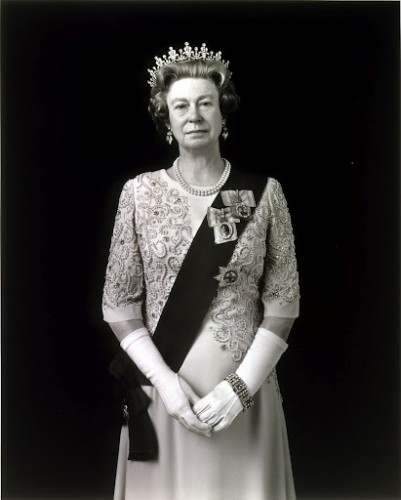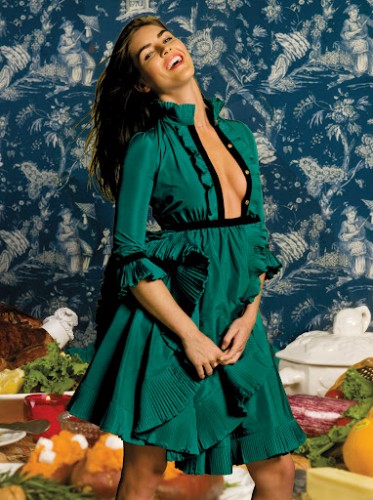
Hiroshi Sugimoto. “Elizabeth II,” 1999. Gelatin silver print, 58 3/4 x 47 in. (149.2 x 119.4 cm). © Hiroshi Sugimoto, courtesy of Fraenkel Gallery, San Francisco, and Pace Gallery, New York.
The photographic image is in many ways the quintessential artistic medium of postmodern culture. The photograph, on account of its proliferation and its ubiquity, its inherent ability to be reproduced and the ease with which it can be altered and manipulated, has for decades now been at the center of artistic and theoretical inquiries into the blurring of the distinction between what is real and what is artificial in contemporary visual culture. The authority and authenticity once ascribed to the photographic image, its ability to impart some sort of objective reality or knowledge of a deeper, immutable truth, has in the postmodern age given way to an appreciation of the photograph’s artifice, to an awareness that its meaning is contingent upon culturally variable social, linguistic, and ideological conditions and contexts. The exhibition Real to Real: Photographs from the Traina Collection, currently on view at the de Young Museum in San Francisco, consists of over 100 works arranged into four discrete groupings intended to focus attention on some of postmodern photography’s core concerns: “The Everyday,” “Excesses,” “Spectacular” and “Losses.” By way of this curatorial choice, Real to Real presents a range of artistic strategies and practices that consider the implications of a postmodern understanding of the photographic image on our notions of “the real” and explore our desire to continue to believe in the enduring power of the photograph.
Of all the exquisite works in Real to Real, Hiroshi Sugimoto’s Queen Elizabeth most succinctly encapsulates what is perhaps the most fundamental shift to take place in our cultural understanding and positioning of photography. The change in question is from a modernist stance, in which the photographic image was largely considered to be a transparent reflection of the world before the camera, to a postmodern stance, in which the photograph is considered within the context of the formative role it plays in constructing our reality in an (increasingly) image-saturated world.
Sugimoto’s large scale photograph Queen Elizabeth is a portrait of a wax likeness of the titular queen, shown in three-quarter-length view, dramatically lit and isolated against a black background. The effigy is so astoundingly lifelike and Sugimoto’s image so richly detailed that one assumes the photograph was taken from life, but of course it was not. Instead, it is a photograph of a three-dimensional effigy found in wax museums, simulacral figures which are themselves often based on other painted or photographed portraits of the famous personages (or sometimes even an amalgam of other images). Sugimoto’s portrait of Queen Elizabeth revels in—and becomes a meditation on—the complex relationship between reality and its representation, as the photograph’s different degrees of separation from its subject complicate the image’s connection to its presumably singular source.
Sugimoto’s photograph insists on presenting the iconic queen as just that, an icon. We recognize that this is Queen Elizabeth before us, but we also come to realize that this picture, along with our own image of the queen in our minds, is but a representation—an idea really—known through the lens of mass media and popular culture. Sugimoto’s portrait is of a persona not a person, the instantly-recognizable figure revealing our cultural and commodified fascination with history and celebrity. Sugimoto’s uncanny, hyper-realistic portrait continues to transmit the intense psychic charge of an actual portrait, thwarting the rational side of our brain that tells us it is but an iconic representation and foregrounding our enduring desire to believe in the power of photography to summon forth the real, to believe that some kernel of truth about the person depicted might be found.
Sugimoto’s play with the conventions of portrait photography and our concomitant expectations as viewers neatly draws attention to the trend in postmodern photography of adopting various modes of representation in order to prompt certain responses from viewers in order to examine how photographic meaning is produced through artistic and mass-media conventions. Indeed, many photographs exhibited in Real to Real look like candid snapshots, but are instead meticulously orchestrated images that only look spontaneous and unscripted. Other images have the look and feel of documentary photography but are instead pictures of utterly staged, decidedly fictionalized scenes. The result is that when looking at Sugimoto’s and other photographs in Real to Real one cannot help but get a creeping sense of our separation from the real, a sense of the formative role images play in determining how we view ourselves and understand the world around us, and of the power images have in shaping and framing our thoughts and our desires. Roe Ethridge, one of the younger photographers in the exhibition, has embraced this hall-of-mirrors impulse in postmodern photography to elide the distinction between what is real and what representation.

Roe Ethridge. “Thanksgiving 1984 (Green Dress),” 2009. Chromogenic print, 44 x 33 in. (111.8 x 83.8 cm). Courtesy the artist and Andrew Kreps Gallery.
At first blush, Ethridge’s photograph Thanksgiving 1984 (Green Dress) seems decidedly familiar. I cannot help but feel that we have encountered this image sometime, somewhere before, even if I can’t quite put a finger on exactly where or when. Jasper Johns once described the symbols he chose to paint—flags, targets, etc.—as “things the mind already knows.” This idea, that the artist culls symbols and subjects from an inventory of culturally familiar sources whose meanings are pre-conceived and pre-established, is certainly applicable to Sugimoto’s portrait, and seems particularly relevant to any discussion of Ethridge’s work. But whereas Sugimoto re-photographs specific objects and imagery from popular culture, Ethridge deftly appropriates the look and veneer of commercial advertising, the aesthetic codes and conventions of consumer culture.
Thanksgiving 1984 (Green Dress) has the look and feel of an image culled from a stock photography catalog precisely because it employs the visual language of commercial photography: its vibrant, highly saturated colors and carefully balanced formal composition, its young, beautiful model, and a spread of products and produce arranged for no other purpose than our visual consumption. But in a neat postmodern twist, Ethridge’s meticulously constructed image reveals itself as just that, a construction. Looking further at the image, it becomes apparent that the scale is off between the model and the surrounding objects and the depth of field is inconsistent, giving the composition a collaged or Photoshopped feel. The model’s pose and expression, meant to signal warmth, spontaneity and naturalness, seem contrived, and her seductive, couture dress appears incongruous with the image’s theme of domesticity and the family-oriented ritual of Thanksgiving. The model’s perfect smile, dress and carefully positioned body reveal not a family snapshot but an image deeply informed by the conventions of the commercial advertisement and the telltale signs of the packaging of luxury goods. It is perhaps not surprising, then, that the title of Ethridge’s photograph foregrounds the luxury item presumably being hawked, should this have been a real advertising image: the green dress.
His photograph is a seductive send-up of bourgeois aspirations, fantasies and desires; it deploys the conventions of advertising while simultaneously lampooning them. Ethridge’s image does indeed reflect back to us things the mind already knows, but in this case, what has seeped into our subconscious are advertising’s visual codes and the photographic conventions of a consumer culture devoted to pleasure, seduction and commerce. By reveling in the photograph as a photograph, Sugimoto, Ethridge and other artists in Real to Real continue the postmodern turn toward simultaneously exploiting and critiquing the role of photography in mass culture and the artifice of its technologies and effects. One takeaway from this exquisite photographic exhibition is that photography continues to be perhaps the most meaningful and fruitful medium for the exploration of the complex interplay between reality and its representation—that main tenet of postmodern thought—which, in the twenty-first century, has never been more relevant, and the distinction between the two never finer.
Real to Real: Photographs from the Traina Collection is on view at the de Young Museum in San Francisco through September 16, 2012.



